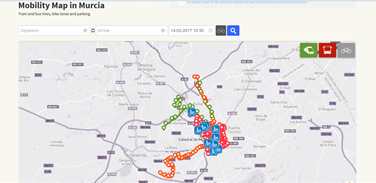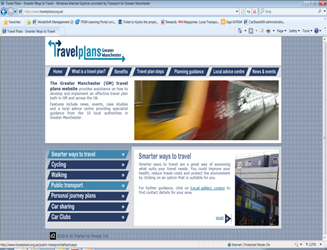Transport and mobility/ Efficient and integrated transport solutions - Optimization of the urban transport system
References/sources
References are provided regarding 3 showcases:
Multimodal advice to travellers, Sofia, Bulgaria (MODUM project)
Sharing information platform, Murcia, Spain
Journey planning through ICT assistance, Manchester, UK
Who needs to act?
The municipality is the initiator of any measures/or actions which refer to mobility management, while the concrete interventions can be implemented by private operators (mobility agencies, transport companies, utilities) upon agreement with the city council.
Who is affected?
The actions are to serve the all users incl. citizens, transport companies, stakeholders, tourists, local community.
Solution
The action tackles a set of actions and measures aimed to optimize the urban transport systems in the big cities through application of integrated soft measures and investment activities. Based on the assumption that the big cited suffer from the heavy traffic and transport dependencies, the present solutions are based on combination of innovative and advanced applications using ICT technologies, infrastructure development and campaigning measures. ICT technologies incorporate establishment of intelligent online transport system, installation of GPS modules to track the bus lines and regulate the transport. Infrastructure development regards reorganization of urban transport through construction of BRT corridor, bicycle paths, update of public transport fleet. Campaigning measures include organization of information and dissemination activities targeted to the residents and guests of the city.
Investment
The level of investment is considered as high as it has to be realized in several phases, interrelated with one another starting with feasibility studies, planning and programming and going forward to real construction and reconstruction activities and supplementary measures. Costs are related with infrastructure development, human resource development, and research and innovation activities for ICT application, information and awareness raising campaigns.
Return of investment
Return of investment is mid-term. The use of alternative transport modes will continue to be actively promoted and utilize and the mobile applications will be continuously developed and incorporated in the mobility schemes.
Assumptions state an investment return up to 20%.
Other resources to be used
Additional resources can be allocated for support and collaboration with the local stakeholders, transport companies and providers, energy companies, development agents, etc.
Available tools
Operating processes:
Multimodal advice to travelers
The city of Sofia has been appointed for a trial study aimed to reduce the carbon emission and duration of journeys in the urban centre. The reason for selection was that the traffic density is very high and to include corridors where multimodal trips (public transport services, park& ride, cycle lanes, etc.) were possible.
The idea was multimodal advice to travellers to be offered. Test users (volunteers) had to register online using smartphone running Android 4.2. or higher and had to commute within the trial study area. Three types of scenarios have been enacted by the test users: A. driving in a congested city. B. car users switching to other modes of transport. C. use of multimodal transport. The specific performance indicators that were measured across these scenarios included reductions in carbon emissions, commuting duration, uncertainty of journey time, and overall congestion as well as a change in modal split. To ensure that the travel data gathered were comparable, the participants were required to predefine their route origin and destination upon registration. Entry of their commute was completed through selection of an origin and arrival location within a map interface. Input of time spent on modes of transport was also captured to ascertain participants’ typical commute from which changes in behaviour were measured.
In order to be able to measure the indicators mentioned above, the trials were conducted across two phases: The first phase, a control period, required participants to complete 5 journeys as per their typical commuting behaviour with no advice from the system. The second phase saw participants complete at least 20 journeys, where they received advice from the system and followed this advice by choosing either the fastest or greenest route to their destination.
The general aim of the pilot test was to reduce the carbon emissions and duration of journeys in urban centres, through providing real time multimodal advice to travellers.
Key success factors:
The main results from the practice showed that it was feasible for a city to provide such an app, thereby directly tying into the needs of daily commuters who wish to more efficiently organise their personal mobility. It was also a huge bonus for such systems which provide routing advice referring the fact that transport information can be seamlessly integrated within the application framework.
Sharing information platform, Murcia, Spain
The government of Murcia has developed an interactive methodology for identification and determination of cycling routes across the city of Murcia to serve the citizens and guests of the city. For the purpose ICT application has been developed for the available transport network including public transport means, roads, cycle lanes, etc. A preliminary research has been accomplished to identify the needs and incentives for the proper transport management and satisfying the users demand.
It is online tool enabling the potential user to find the most appropriate route via transport mode while crossing the city. Thus, the objective to achieve a better time, cost and resource efficiency is to be ensured. Each potential user can benefit of better planning travel behavior and achieving efficiency of journeys. A specific methodology for designing the cycle lane network using ICT and geolocation has been elaborated and integrated. Additional measures for parking areas have been modified to boost intermodality.
Everyone who wants to plan his travel and/or stay in the city may visit the official website (www.mutrans.es) and organize his trip in the most efficient way.

Journey planning through ICT assistance, Manchester, UK

As a metropolitan county in the North-West England Greater Manchester has developed a travel choices programmes which serves the various preferences of the travellers. It is an online platform providing a number of travel choices by application of interactive ICT tools.
The mobile “real time” travel information service is for users on the primary school run. In fact, it is an application that enables the visualization of a walking school bus (WSB) by predicting and tracking the pre-determined safe route of the pupils. Users can see where the WSB is located at any particular point in time or should be in immediate future.
It is the Station Travel Planning (STP) programme which enables the access to rail stations and tramp stops across Greater Manchester with a focus on encouraging cycling to cycle ride and stations. The user the better plan his/her travel options by visualization of the most sustainable ways.
The Travel Planning Toolkit provides specific package of measures to encourage commuters to use travel choices available. By utilization of ICT application, the frequently travelling users can determine the most efficient and cost saving travel by less time consuming.
Advantages:
The travel choices programmes offer five progressive acquisitions for the users:
- Sustainable access – network of cycle routes is established across Greater Manchester
- Travel Choices – wide range of travel choices for commuters, businesses and jobseekers is provided
- Smarter Technology – real time travel by web or mobile and smart ticketing system is enabled
- Enabling community transport – demand responsive transport for connecting people is ensured
- Commuter Cycle Project – toolkit of measures including cycle training, secure cycle parking facilities, cycle infrastructure improvements are offered
The municipality takes decision how to organize and manage the transport system and the city council votes. The service is provided by a specialized entity following the technical specifications.
In general, this kind of action is based on preliminary findings, feasibility studies and concrete measurements of transport indicators among which are: number of travel choices made with private and/or public vehicles, travel behaviors and number of users, etc. An action plan is needed to be developed with specific design and allocation of measures. Consolidation activities with the relevant authorities at every step of the action implementation (as for issue permission, administrative procedures, etc.) should be enacted
Main steps of implementation
- Planning and Programming based on feasibility study - Project design.
- Project start-up.
- Consolidation of the relevant authorities at all steps of implementation (issue permissions, administrative procedures, etc.) cooperation between the relevant departments within the municipality.
Expected results
Short and mid term
- Achieve modal shift from car travel to sustainable transport modes
- Reduced number of private cars in the urban areas
- Increased use of public transport
- Improved customer satisfaction with end to end journeys as a result of the station travel plan
Mid and long term
- Improved local infrastructure to use transport efficiently and sustainable transport means, efficient mobility, etc.
- Better quality of life of local citizens – low carbon performance, sustainable applications.
- Increased level of perception and appreciation of integrated transport measures
- Increased local economy through utilization of the innovations.
Contribution to SEAP & indicators
Reduce traffic burden in urban areas.
Reduce CO2 emissions.
Increase of energy efficiency, environmental indicators and quality of citizens life.
How to integrate in SEAP?
To set as a measure incl. qualitative and quantitative indicators.
Contribution to SUMP & indicators
Reduce traffic burden in urban areas.
Reduce CO2 emissions.
Increase of energy efficiency, environmental indicators and quality of citizens life.
How to integrate in SUMP?
To set as a measure with concrete actions for definite period of time. Allocate specific qualitative and quantitative indicators.
Lessons learned
Close communication and cooperation with the local citizens is a very important tool for better development of a planning process, setting specific indicators and reaching definite results. The regular feedback could serve as a key point to re-formulate ideas, change if anything goes wrong or planning better resources and actions.
One of the success factors for involving citizens and all interested parties in the process of creation and introduction of innovative ICT tools is the establishment of local working groups. Representatives of all stakeholders are invited and proactively participate in decision making process and adoption of innovative transport solutions.
Another very important side of the implementation of ICT in transport is the involvement of volunteers and/or universities and their students in the feasibility study phase of the ICT apps introduction. The R&D universities’ centers could serve as valuable hubs both for creation of innovative ICT tools and for their testing and initial introduction among young people.
Amongst the beneficial ICT approaches is detected to be the Internet and social networks communication. This is the way for fast and fruitful cooperation with the target groups and the potential beneficiaries.
Last, but not least, the cooperation with central and local authorities and institutions, local business and financing organisations from all economic fields (health, social, transport, business, etc) gives advantage to any ICT campaign and is a guarantee for its success.

